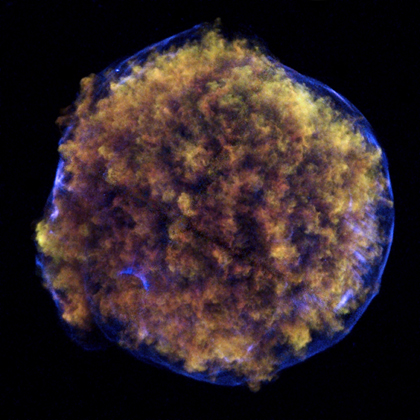For Release: April 26, 2011
CXC
CAMBRIDGE, Ma. -- Astronomers may now know the cause of an historic supernova explosion that is an important type of object for investigating dark energy in the universe. The discovery, made using NASA's Chandra X-ray Observatory, also provides strong evidence that a star can survive the explosive impact generated when a companion star goes supernova.
The new study examined the remnant of a supernova observed by the Danish astronomer Tycho Brahe in 1572. The object, dubbed Tycho for short, was formed by a Type Ia supernova, a category of stellar explosion useful in measuring astronomical distances because of their reliable brightness. Type Ia supernovas have been used to determine that the universe is expanding at an accelerating rate, an effect attributed to the prevalence of an invisible, repulsive force throughout space called dark energy.
A team of researchers analyzed a deep Chandra observation of Tycho and found an arc of X-ray emission in the supernova remnant. Evidence supports the conclusion that a shock wave created the arc when a white dwarf exploded and blew material off the surface of a nearby companion star.
"There has been a long-standing question about what causes Type Ia supernovas," said Fangjun Lu of the Institute of High Energy Physics, Chinese Academy of Sciences in Beijing. "Because they are used as steady beacons of light across vast distances, it is critical to understand what triggers them."
One popular scenario for Type Ia supernovas involves the merger of two white dwarfs. In this case, no companion star or evidence for material blasted off a companion should exist. In the other main competing theory, a white dwarf pulls material from a "normal," or sun-like, companion star until a thermonuclear explosion occurs. Both scenarios may actually occur under different conditions, but the latest Chandra result from Tycho supports the latter one.


